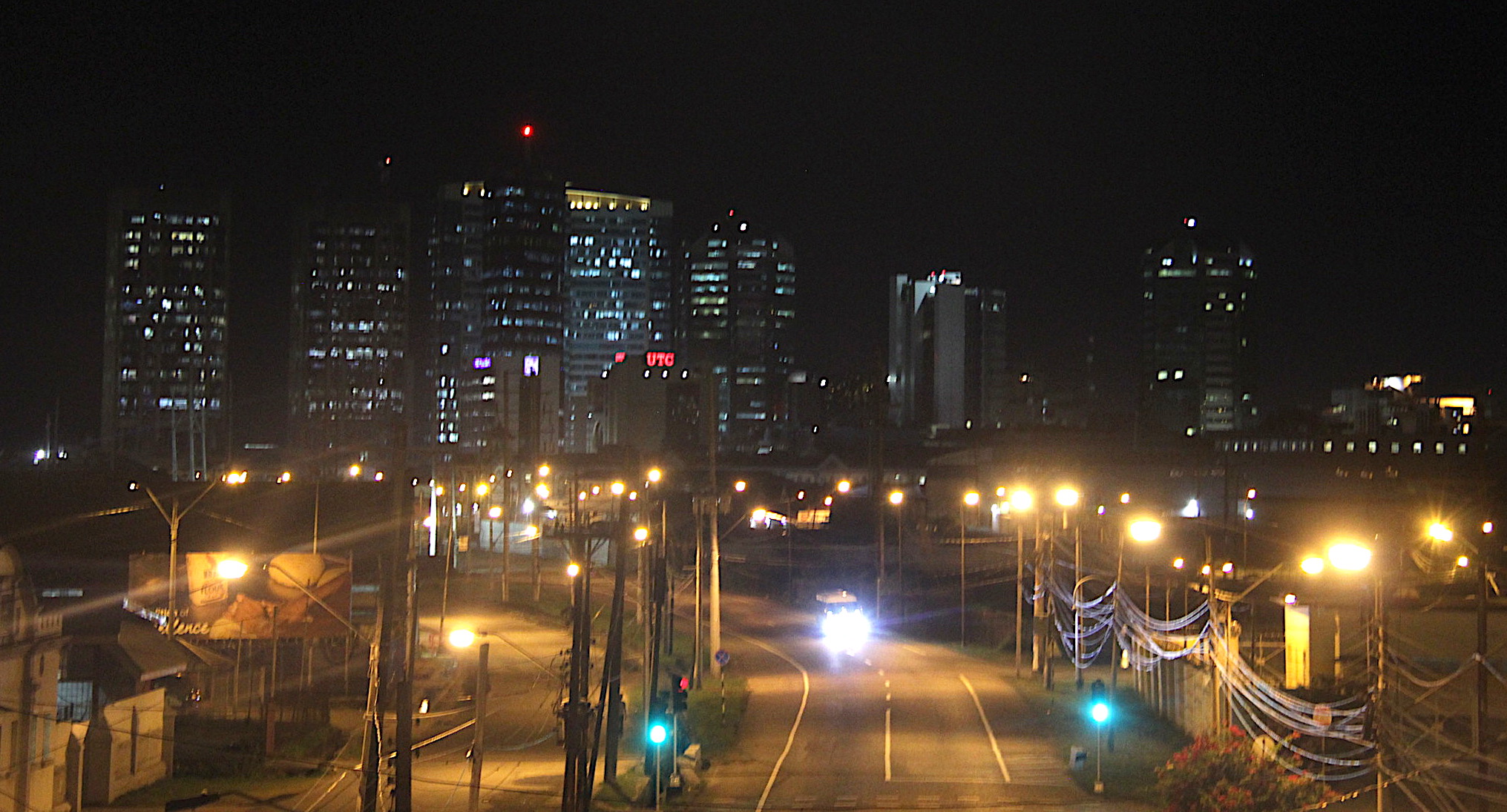Trinidad and Tobago’s 1.4 million citizens are about to learn how decades of subsidized electric rates are going to cost them dearly. The twin-island republic’s once abundant supply of natural gas has been used to generate electricity for residential, business and industrial customers at far below market prices.
Beginning in the 1970’s, successive governments discounted Trinidad’s electricity costs to everyone. It proved incredibly popular among voters. Today, it is being sold to residential customers at a mere US$ 0.05 per kWh. That lowest tier price is among the cheapest rates in the world.
There have been unwanted consequences as the subsidies distorted the markets. Per capita consumption is the highest in the Caribbean. Investments in alternative energy sources are nearly non-existent. The politicians who must raise rates in recognition of waning supplies of natural gas are confronting difficult choices which will undoubtedly impact everyone. Even if they don’t get a higher electric bill at home, prices for commodities like food, clothing, appliances and electronics could increase as retail businesses face higher overhead.
It will fall on the politicians to try to soften the blows, adjust pricing tiers to protect those least able to afford it. They may make adjustments to assist industries powering the economy. How all of that will be balanced, who will pay the most and other questions have yet to be answered. Politicians and stakeholders say what is clear is that change and higher prices lie ahead.
Subsidies Slack T&T’s Electric Rates
We enjoy the cheapest rates in the Caribbean and perhaps among the cheapest in the world because they’re heavily subsidised. We don’t really pay the true market price of electricity generated.
Kishan Kumarsingh, TT Ministry of Planning
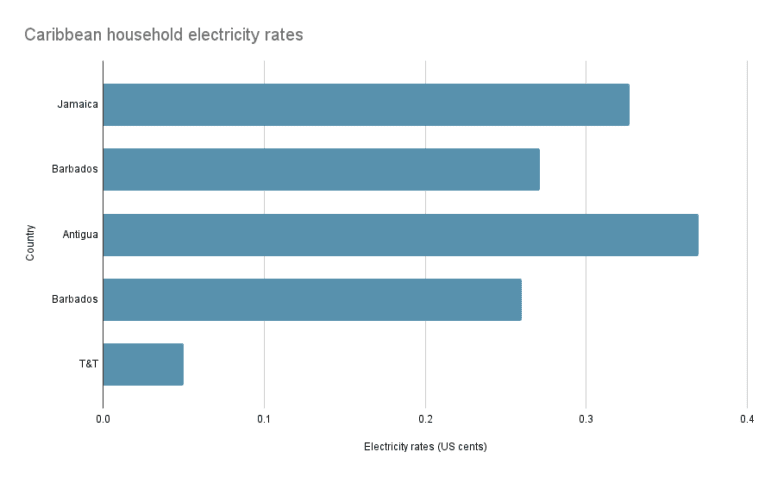
There are few rivals to such generous electricity rates in this part of the world. The cost only increases as you go up the Caribbean chain. St Kitts and Nevis pays five times more than Trinidad and Tobago while Antigua and Barbuda pays more than seven times that rate. Dr. Curtis Boodoo, a consulting engineer on the United Nations Development Programme’s Community Solar Project, told CIJN, “When you look at the Gulf states, oil and gas producers with relatively low populations, it is perhaps better to compare our electricity rates with them.” [In Saudi Arabia, according to Global Petrol Prices, households pay $US0.048 kWh. Qatar is slightly lower at $US0.032.]
Trinidad and Tobago’s low rates aren’t magic. Brendon James, a sustainable energy and risk management professional who has worked in the energy industry for more than two decades, says it’s a confidential arrangement between the National Gas Company (NGC) and T&T Electricity Commission (T&TEC). That arrangement is defined by how much the government is willing to discount its natural gas holdings.
Low Rates Encourage Increased Consumption
For years, energy experts and the government’s own analysts have warned low electricity rates were encouraging consumers to conserve less and, in effect, keep the lights on. The U.S. Energy Information Administration statistics show Trinidad and Tobago residents consume multiple times more electricity than their Caribbean counterparts.
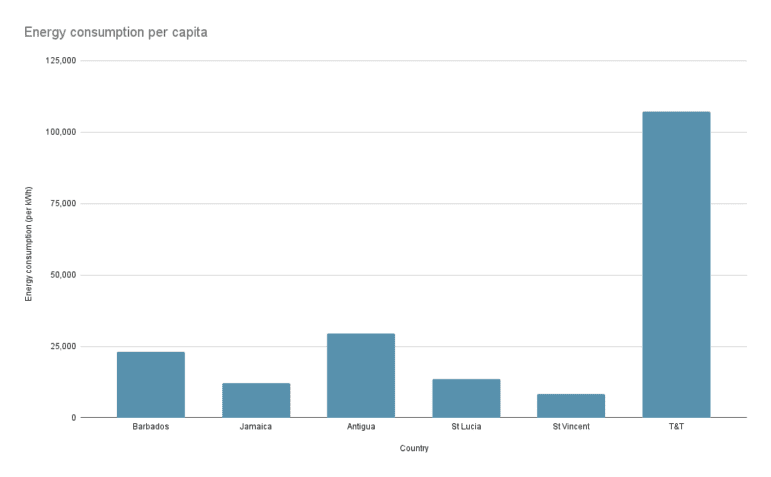
While some countries are speaking about climate change and an increase in temperatures in the Caribbean, data shows Trinidad and Tobago residents’ consumption of electricity continues to increase. The residential usage of electricity in the twin-island state in 2010 stood at 28.7%. By 2021, that figure had jumped to almost 40%. As a heatwave gripped the country in September, T&TEC recorded a new record in demand for electricity.
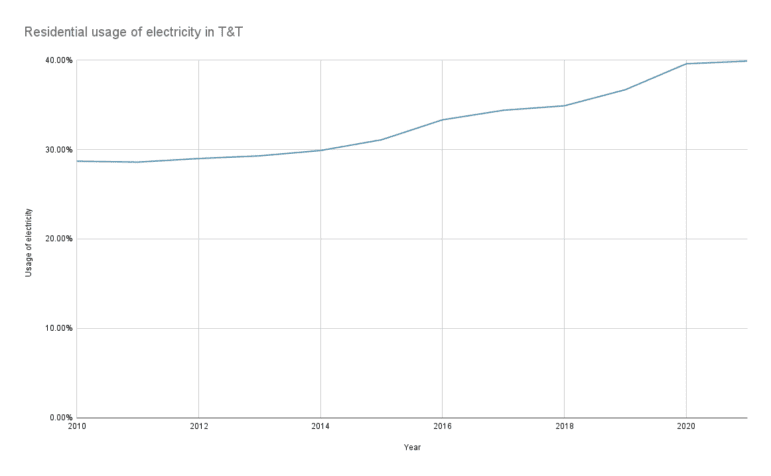
At the same time, industrial use of electricity has decreased from 60% to 48% between 2010 and 2021 according to Energy Chamber statistics.
Last year, Trinidad and Tobago consumed 107,269 kWh per capita, according to a study done by the U.S. Energy Information Administration. The EIA says Jamaica with a population of 2.8 million people, consumed an average of 12,236 kWh per capita in 2021. In the same year, Barbados consumed 23,026 kWh per capita.
Chief Executive Officer (CEO) of the Energy Chamber, Dr. Thackwray Driver, has been vocal on the need for citizens of Trinidad and Tobago to pay a fairer price for the electricity they consume. He told CIJN, “There is no reason why the state should subsidise somebody to have a centralised air conditioning, swimming pool pumps. There are people in Trinidad who actually have electric heaters for their swimming pools. Why should the state be subsidising someone who has an electric heater for their swimming pool? If they want to have it, it’s fine but they should pay the full cost of the electricity for something like that.”
Gas Subsidies Undermine Alternative Energy
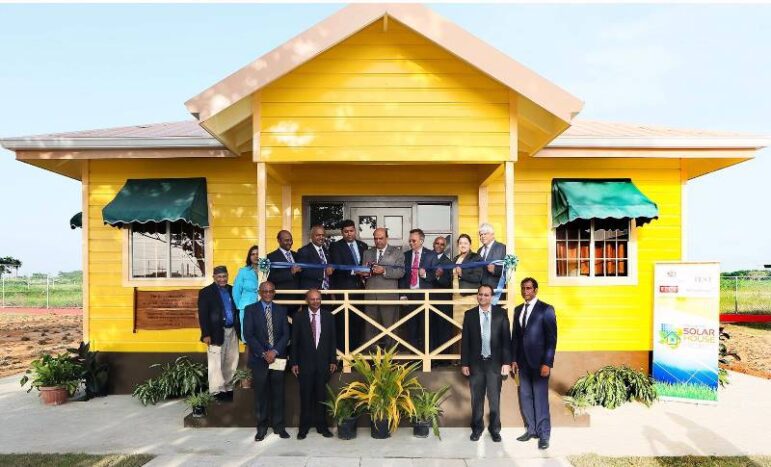
The government of T&T has long been aware of the economic, social and environmental advantages of a transition to alternative energy. The Solar House, built eight years ago on a University campus about 1.5 hours from the capital, still stands as a prototype. But the reality is that with the historic availability of natural gas there’s been little or no investment into the residential solar market.
Dr. Boodoo, who remains engaged with the Solar House project, acknowledges the country’s entire energy transition has failed to materialise.
Dr. Driver agrees. “Our view would be that, no, we haven’t moved fast enough in this direction. There are some things that are putting us on the right pathway but we’ve got to move a lot faster. We have this large investment solar project from BP and Shell in Pt. Lisas, Brechin Castle and the one in Orange Grove so there are two in execution. [Both are expected to be operational in late 2024]
Dr. Driver went on to say “we need to move much faster but to do that we need to get the regulations amended.” It’s a common chorus from industry experts. The necessary policy changes haven’t been implemented. In April this year, Prime Minister Dr. Keith Rowley broke ground for the construction of a utility-scale solar plant at Brechin Castle making a commitment that changes to regulations would be introduced within months but it is yet to happen. Dr. Driver says it will give a clear way for the private sector and individual households to put solar panels in place and have a system where their electricity bill will be offset.
“At the grassroots level where citizens can participate in this is really what is needed now to empower the citizen to contribute to our own Nationally Determined Contributions (NDCs). To do that, just like the large-scale investment, we need a proper enabling environment. One critical part of that enabling environment is the feed-in tariff policy.” With such a policy, ordinary citizens can install solar panels and generate electricity. Any excess could be sold back to the utility.
Dr. Boodoo points out it requires a US$430 licensing fee that can take more than nine months to acquire. He says the current version of the renewable energy license form requires the signature of the Minister of Public Utilities.
“The internal processes that are currently in place around solar energy, they are serving as a barrier to the public in its adoption,” Dr. Boodoo told CIJN. He further pointed to the conflict of a utility company such as T&TEC being the gatekeeper to enable the use of renewable energy. “It’s natural for the utility not to encourage the adoption of renewable energy because if people generate their electricity at home then they’re not paying for that electricity.”
It is why Dr. Boodoo believes there needs to be “institutional change” in the granting of renewable energy licenses and its adoption. He says instead of the Ministry of Public Utilities, it should be led by the Ministry of Energy, which he believes is “progressive” towards more greener forms of energy.
Over the last decade, the Ministry of Energy has announced a number of fiscal incentives to encourage the move towards renewable energy. For instance, import duty exemptions were granted for machinery, equipment materials and parts for the manufacture or assembly of solar water heaters. Also, 0-Rated VAT was granted for solar water heaters, solar PV panels and wind turbines. However, Kumarsingh is adamant very little will come of the incentives unless much of the red tape is cut out. He told CIJN, “Fiscal investments wouldn’t mean anything unless the enabling environment is there. You can have all of the amount of money be given to you through grants and loans and so on, it would mean nothing if you can’t implement the actions that it is meant to achieve. It’s about getting the first step correct that will facilitate the actions that are needed.”
He has also long advocated for the feed-in tariff policy to be implemented allowing consumers to sell excess back to the utility. Kumarsingh explained to CIJN, “What that will do, basically, is buffer the impacts of any rate increase.”
Power, Pain, and Politics
The key question for Trinidad and Tobago’s citizens is not whether their electricity rates are going up. The questions are “When?” and “By How Much?”
So-called “Draft” rate structures have been floated since late in 2022 and raised eyebrows when they were reported in the media. In the first year alone, residential customers could see 20% to 33% rate hike depending on their kWh consumption. Further incremental increases would be imposed over a 5-year span.
Business and Industry could face a 68.5% rate hike in the first year alone.
Those steep hikes mean cost increases for food and other essentials as businesses are forced to pass on their operating expenses to consumers.
It comes as no surprise that all of Trinidad and Tobago’s political parties that bestowed the gift of subsidies on their electorates are now timid about announcing the actual end to them. The optics are terrible. It’s as if Santa Claus will be visiting every household to make the children pay for the presents of Christmas past.
A review of the country’s rates is now in its advanced stages. Between six and eight per cent of the country’s natural gas supply is used for electricity consumption, a resource that industry experts believe is better directed to the petrochemical sector and gas export markets.
“It has been a long time coming. A number of key stakeholders and global events have assembled for us to be ready to make some severe and significant decisions in the energy sector,” Dr. Curtis Boodoo, a consulting engineer on the United Nations Development Programme’s GCCA+ Community Solar Project, told CIJN.
Minister of Public Utilities, Marvin Gonzales, confirmed the price hike on a recent radio programme. He told a morning radio talk show, “As Minister of Public Utilities I can tell you from what I have seen, there will be an increase in rates. There will be a new rate structure. I suspect it could be any time.”
Residents of Trinidad and Tobago seem ready for the transition. A UNDP Public Awareness Survey on Renewable Energy, Energy Efficiency and Energy Pricing this year showed 81% of people surveyed say they are interested in installing solar panels in their homes.
For a country that has been in the oil and gas business for more than a century, T&T is at another energy crossroads when it comes to energy. Dr. Boodoo recalled, “In the early days of the natural gas sector [the 1970’s] when Professor Ken Julien would have led that, somebody my age or a lot of younger persons would be led to believe that natural gas was the obvious choice but if you listen to Professor Julien, there was some resistance. I see parallels in the energy transition now. We are now at that stage where we need to take that risk and somebody has to make the decision and take the risk.”
The political leadership is yet to offer a detailed roadmap for the energy transition. How will they handle the risks? How much are they prepared to invest in alternative energy? How will they engage international agencies such the UN and the World Bank to expand the potential of solar and wind? The failures of the past are clear. What Trinidad and Tobago citizens want now is a vision for their future.
